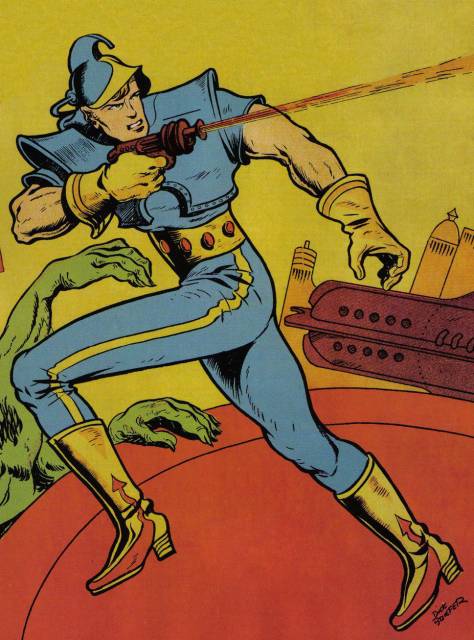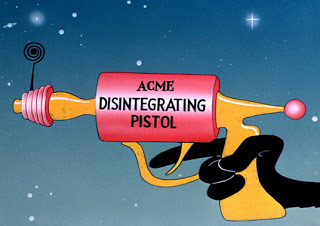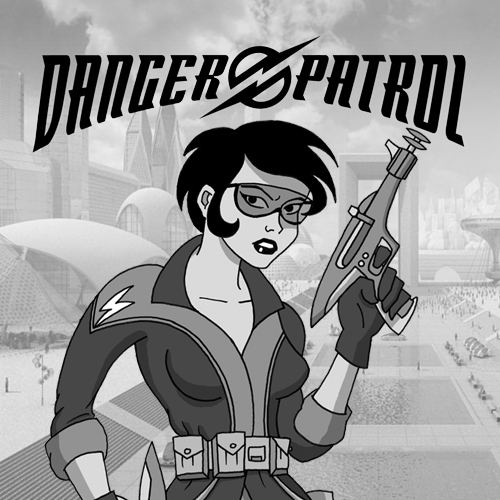You Should Be Playing…
Danger Patrol
The shadowy form of Lord Phlegos of the Stygian Adepts lifts his voice in a discordant song, his fellow cultists raising up their wickedly curved daggers. As one, they plunge their daggers into their chests, falling onto the spiraling carving in the ancient stone. Their blackened blood fills the carving, as an indigo light suffuses the chamber.
Lord Phlegos finishes his incantation, pointing his grey-skinned finger towards the Danger Patrol, laughing as power courses through his form. “Your atomic blasters are useless against the chtonic might of Xcthuul!” he calls out as the forms of his cultists are torn apart from within by writhing, metallic forms. You recognize the ancient Platinum Spiders of Deimos from the carvings of lost Atlantis, called once more into being by Phlegos’ mystic might. Cackling with wicked delight, Lord Phlegos lifts from the ground. “Prepare yourselves, Danger Patrol! Prepare… for OBLIVION!”
And now, a word from our sponsors…
 Danger Patrol is a game of pulp action adventure set against a backdrop of speculative fiction. Written by John Harper and produced by One Seven Design Studio, it has yet to be released as a final product. The current rules, released in 2010, serve as a beta test for the game. While no release date has been given, the game presented in the beta test is both playable and very enjoyable. Developed under a Creative Commons license, it is currently available for free download from their website. Additional games from One Seven Design Studio are available as well, most of them being offered also for free.
Danger Patrol is a game of pulp action adventure set against a backdrop of speculative fiction. Written by John Harper and produced by One Seven Design Studio, it has yet to be released as a final product. The current rules, released in 2010, serve as a beta test for the game. While no release date has been given, the game presented in the beta test is both playable and very enjoyable. Developed under a Creative Commons license, it is currently available for free download from their website. Additional games from One Seven Design Studio are available as well, most of them being offered also for free.
In the world of Danger Patrol, Earth has been destroyed through the abuse of atomic power. Left with no alternative, the people of Earth fled its destruction on various rockets, spreading into the solar system and re-establishing themselves. The largest of these settlements is Rocket City, the “city of the future” built by millionaire Hamilton Hawks on Olympus Mons. The skies of Rocket City are filled with the gleaming movement of rocket-cars funneled into magnetically controlled traffic lanes, and massive skyscrapers tower thousands of feet above the surface of the red planet. Rocket City is the central hub around which humanity turns, and it is the job of the Danger Patrol to protect it from the various threats of the solar system.
Inspired by the serials of Flash Gordon and Buck Rogers, Danger Patrol hearkens to the ray gun gothic of 1950’s science fiction. Unconcerned with the more modern distinctions between hard science fiction, fantasy, space opera, and others, Danger Patrol is a game that celebrates the tropes and conventions of those stories. It channels the same energy that has made shows like The Venture Bros. and Warehouse 13 successful, bringing more than just a sense of nostalgia to the table. Danger Patrol is a game of larger than life heroes battling sinister and treacherous enemies, but it never loses sight of having fun.
What Makes A Hero
Character creation in Danger Patrol is straightforward and descriptive. Players choose a Style and a Role combination for their characters, with no two players being allowed to pick the same exact combination. Characters are allowed to share a Style or a Role, but not both. There are eight different Styles and eight different Roles in the beta rules provided by Danger Patrol, and the formula for creating more is easy to replicate.
 A character’s Style provides them with an origin and a source of power, ranging from the magic of the Mystic, the cybernetics of Atomic, or the reliability of Two-Fisted. A character’s Style grants them a Talent, a Power, and four Special Abilities; A character’s Role describes what the character brings to the table, be it the combat mastery of a Warrior, the knowledge of a Professor, or the risk-taking of a Daredevil.
A character’s Style provides them with an origin and a source of power, ranging from the magic of the Mystic, the cybernetics of Atomic, or the reliability of Two-Fisted. A character’s Style grants them a Talent, a Power, and four Special Abilities; A character’s Role describes what the character brings to the table, be it the combat mastery of a Warrior, the knowledge of a Professor, or the risk-taking of a Daredevil.
Their Role dictates their main Trait, and it provides an additional Talent and Power. A Role also comes with Gear & Weapons. The player then distributes their character’s Trait Dice among the seven remaining Traits, each corresponding with a particular Role. These Trait Dice range from a d4 to a d12. Finally, a player chooses their character’s uniform colors, weapon of choice, and identity.
Each Talent generally provides a character the ability to bend or break one of the rules of the game, and Powers serve as special maneuvers characters can unlock during game play. Both Special Abilities and Gear & Weapons grant bonus dice on rolls, and are exhausted after use. They can be refreshed during interlude scenes, however. With sixty-four different possible Style and Role combinations, a party of three to five heroes should not have a problem of overlap. Building Danger Patrol as a group, however, is very helpful in making sure that every base is covered.
Gameplay
Each session of Danger Patrol is designed to start in media res, with play picking up at the start of an Action scene. The Game Master reads a Teaser, such as the one that starts this article, setting the scene of the session’s action and plot, and then opens the floor with the phrase “Previously, on Danger Patrol…” Players then take turns narrating a brief scene in a previous “episode” with elements they wish to see in the current one. Once all players have provided their ‘Previously On’ scenes, the Action begins. The GM sets up the Action Arena, using index cards to visualize the scene’s threats and obstacles, and then compares the relative positions of the heroes to these challenges. Not every threat is the same, and some need to be overcome before reaching a different threat, just as minions need to be overcome before facing a villain.
 Each player takes a turn describing how their hero acts to resolve the Action of the scene. Players then roll a die base on their applicable Trait to the action, optionally adding dice to the roll via Danger dice or Bonus dice. Danger dice raise the stakes of the roll, and Bonus dice come from a character’s Special Abilities and Gear & Weapons. Dice that roll 4 or more are counted as Hits, while dice that roll 1 to 3 are counted as Danger.
Each player takes a turn describing how their hero acts to resolve the Action of the scene. Players then roll a die base on their applicable Trait to the action, optionally adding dice to the roll via Danger dice or Bonus dice. Danger dice raise the stakes of the roll, and Bonus dice come from a character’s Special Abilities and Gear & Weapons. Dice that roll 4 or more are counted as Hits, while dice that roll 1 to 3 are counted as Danger.
Hits are put towards defeating or solving Threats, while Danger increases a character’s Danger Meter. After the dice are rolled, the GM narrates the results of the character’s actions, and resolves a Threat Move based on how much Danger the character generated. Threat Moves can inflict damage to a character, introduce new threats, or even create a total disaster if bad enough. Play then passes to the next player; once all players have acted, the round is over. A new round begins, and this continues until the Action scene is resolved.
A character’s Danger Meter serves as both an indication of their health and the stakes of the current scene. Depending on the level of their Danger Meter, a character taking a Threat Move may get a little beaten up, stunned, knocked out, booted from an airlock, or even vaporized. As the Danger Meter increases, however, characters also gain access to their Powers, providing them with special ways of changing a scene to their advantage. The number of opportunities to use Powers increases the higher on the Danger Meter the character goes, but so too does the chance of being severely harmed. Every dice added to a roll increases the chance of raising the Danger Meter, and an Action scene can very quickly go from a guaranteed win to a complete loss with a single roll if the Danger is high enough.
Once the Action scene resolves, characters are given an Interlude scene where they recuperate and interact before moving onto a Suspense scene. Here, the characters drive the story of the episode forward in a manner similar to the Action scenes. Instead of facing Threats, however, characters are answering questions. Each player decides what questions their characters are pursuing, and the GM handles them one at at time. Any new threats are placed in the wings for the next Action scene, which begins once the commercial Suspense scene ends. As such, game play proceeds in a process from Action to Interlude to Suspense to Action, until the story is finished. While the beta rules do not provide how many cycles this would take in a normal session, the standard pulp formula would have two full cycles, followed by a final Action scene.
While Danger Patrol is not a finished or polished game, the game as it is currently available is still far more fun and exciting than many games on the market. Pulp action adventure is a style of play with its feet planted firmly in both campy silliness and straightforward escapist fun. Like many of One Seven’s games, Danger Patrol is easy to learn, easy to run, and focuses on gaming as a social activity of give-and-take storytelling. Whether it is fist fighting a cybernetic Crimson Ape of Mars on the back of a speeding rocket car, or foiling the machinations of a Neptunian psi-lord to rig the annual Mayorial election, Danger Patrol keeps the action moving and the stories entertaining.
And that is why you should be playing Danger Patrol.

David Gordon is a regular contributor to the site. A storyteller by trade and avowed tabletop veteran, he is always on the lookout for creative tabletop games. He can be reached at dave@cardboardrepublic.com.
You can discuss this article and more on our forums!
Photo Credits: Danger Patrol logo and raygun poser by Danger Patrol.
